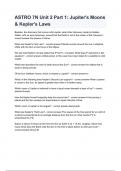Jupiter Study guides, Class notes & Summaries
Looking for the best study guides, study notes and summaries about Jupiter? On this page you'll find 749 study documents about Jupiter.
Page 3 out of 749 results
Sort by
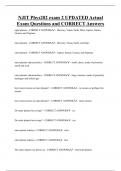
-
NJIT Phys202 exam 2 UPDATED Actual Exam Questions and CORRECT Answers
- Exam (elaborations) • 51 pages • 2024
- Available in package deal
-
- $9.99
- + learn more
NJIT Phys202 exam 2 UPDATED Actual Exam Questions and CORRECT Answers eight planets - CORRECT ANSWER- Mercury, Venus, Earth, Mars, Jupiter, Saturn, Uranus, and Neptune inner planets - CORRECT ANSWER- Mercury, Venus, Earth, and Mars outer planets - CORRECT ANSWER- Jupiter, Saturn, Uranus, and Neptune inner planets characteristics - CORRECT ANSWER- small, dense, made of primarily metal and rock
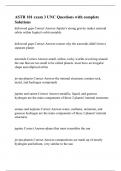
-
ASTR 101 exam 3 UNC Questions with complete Solutions
- Exam (elaborations) • 8 pages • 2024
-
- $15.49
- + learn more
kirkwood gaps Correct Answer-Jupiter's strong gravity makes asteroid orbits within Jupiter's orbit unstable kirkwood gaps Correct Answer-reason why the asteroids didn't form a separate planet asteroids Correct Answer-small, airless, rocky worlds revolving around the sun that are too small to be called planets. most have an irregular shape and elliptical orbits jovian planets Correct Answer-the internal structures contain rock, metal, and hydrogen compounds jupiter and saturn Corre...
ASTRO 7N Unit 2 Part 1 Jupiters Moons & Keplers Laws with complete solution / Latest updated .
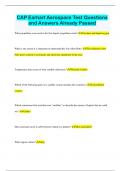
-
CAP Earhart Aerospace Test Questions and Answers Already Passed
- Exam (elaborations) • 22 pages • 2024
- Available in package deal
-
- $9.99
- + learn more
CAP Earhart Aerospace Test Questions and Answers Already Passed What propellants were used in the first liquid- propellant rocket? Gasoline and liquid oxygen What is one reason it is important to understand the Van Allen Belts? The radiation in the belts poses a threat to astronauts and electronic equipment in the area. Temperature data is part of what satellite subsystem? Thermal Control Which of the following parts of a satellite system includes the customers? Constellation sy...
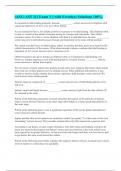
-
(ASU) AST 111 Exam 3 || with Errorless Solutions 100%.
- Exam (elaborations) • 9 pages • 2024
-
Available in package deal
-
- $11.29
- + learn more
Io experiences tidal heating primarily because __________. correct answers Io's elliptical orbit causes the tidal force on Io to vary as it orbits Jupiter. As you learned in Part A, Io's elliptical orbit is necessary to its tidal heating. This elliptical orbit, in turn, is a result of the orbital resonance among Io, Europa, and Ganymede. This orbital resonance causes Io to have a more elliptical orbit than it would otherwise, because __________. correct answers Io periodically passes Europa...
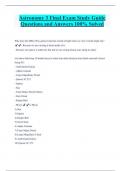
-
Astronomy 3 Final Exam Study Guide Questions and Answers 100% Solved
- Exam (elaborations) • 34 pages • 2024
- Available in package deal
-
- $14.99
- + learn more
Astronomy 3 Final Exam Study Guide Questions and Answers 100% Solved Why does the Milky Way galaxy look like a band of light when we view it in the night sky? ️️- Because we are viewing it from inside of it. - Because our galaxy is relatively flat and we are seeing distant stars along its plane. List these following 10 bodies/areas in order from their distance from Earth outward (closest being #1): - Andromeda Galaxy - Alpha Centauri - Large Magellanic Cloud - Quasar 3C 273 - Ju...
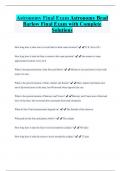
-
Astronomy Final Exam Astronomy Brad Barlow Final Exam with Complete Solutions
- Exam (elaborations) • 16 pages • 2024
- Available in package deal
-
- $12.99
- + learn more
Astronomy Final Exam Astronomy Brad Barlow Final Exam with Complete Solutions How long does it take stars to circle back to their same location? ️️23 h, 56 m, 04 s How long does it take the Sun to return to the same position? ️️Sun returns to same approximate location every 24 h What is the general motion of the Sun and Moon? ️️Motion of sun and moon is East with respect to stars What is the general motion of Mars, Jupiter and Saturn? ️️Mars, Jupiter and Saturn also ...
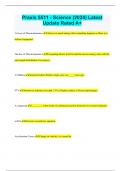
-
Praxis 5511 - Science (2024) Latest Update Rated A+
- Exam (elaborations) • 32 pages • 2024
- Available in package deal
-
- $10.49
- + learn more
Praxis 5511 - Science (2024) Latest Update Rated A+ 1st Law of Thermodynamics Always as much energy after something happens as there was before it happened. 2nd law of Thermodynamics Everything directs itself toward the lowest energy state with the most equal distribution of resources. 4.5 Billion Scientist believe Earth's origin year was ____ years ago. 97% Amount of saltwater on earth, 71% of Earth's surface is Ocean (percentage). A compound ___ _____ is the result of a c...
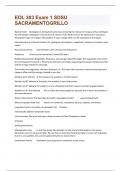
-
EOL 303 Exam 1 SDSU SACRAMENTOGRILLO QUESTIONS WITH ALL CORRECT SOLUTIONS!!
- Exam (elaborations) • 5 pages • 2024
- Available in package deal
-
- $7.99
- 1x sold
- + learn more
Natural Event Geological or atmospheric processes involving the release of energy and has nothing to do with people. Geological is due to the hot interior of the Earth and can be expressed as volcanoes. Atmospheric type of energy is the product of solar energy which can be expressed as tornadoes. Characteristics of a Natural Disaster (5) geological, atmospheric, magnitude, frequency, duration, areal extent Recurrence interval time between same sized events (150 years) frequency 1/recurrenc...
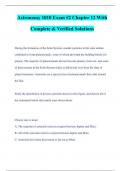
-
Astronomy 1010 Exam #2 Chapter 12 With Complete & Verified Solutions
- Exam (elaborations) • 12 pages • 2023
-
- $10.49
- + learn more
During the formation of the Solar System, smaller particles in the solar nebula combined to form planetesimals, some of which provided the building blocks for planets. The majority of planetesimals did not become planets, however, and some of them remain in the Solar System today as debris left over from the time of planet formation. Asteroids are a special class of planetesimals that orbit around the Sun. Study the distribution of known asteroids shown in this figure, and choose all of t...

How did he do that? By selling his study resources on Stuvia. Try it yourself! Discover all about earning on Stuvia

